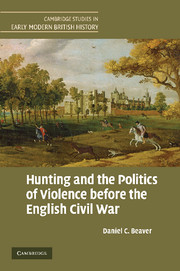Book contents
- Frontmatter
- Contents
- List of maps
- Acknowledgments
- List of abbreviations
- Introduction: Hunting, violence, and the origins of the English Revolution
- 1 Blood, sacrifice, and order: meanings of the forest and hunt in culture, politics, and society
- 2 Honor, property, and the symbolism of the hunt in Stowe, 1590–1642
- 3 Ancient liberties and the politics of the commonweal in Waltham Forest, 1608–1642
- 4 Royal honor, great parks, and the commonweal in Windsor Forest, 1603–1642
- 5 Venison and the politics of honor in Corse Lawn Chase, 1620–1642
- Conclusion: Royal symbols, forest politics, and popular politics in early modern England
- Bibliography
- Index
- Titles in the series
3 - Ancient liberties and the politics of the commonweal in Waltham Forest, 1608–1642
Published online by Cambridge University Press: 06 March 2010
- Frontmatter
- Contents
- List of maps
- Acknowledgments
- List of abbreviations
- Introduction: Hunting, violence, and the origins of the English Revolution
- 1 Blood, sacrifice, and order: meanings of the forest and hunt in culture, politics, and society
- 2 Honor, property, and the symbolism of the hunt in Stowe, 1590–1642
- 3 Ancient liberties and the politics of the commonweal in Waltham Forest, 1608–1642
- 4 Royal honor, great parks, and the commonweal in Windsor Forest, 1603–1642
- 5 Venison and the politics of honor in Corse Lawn Chase, 1620–1642
- Conclusion: Royal symbols, forest politics, and popular politics in early modern England
- Bibliography
- Index
- Titles in the series
Summary
John Browne and others in April last assembled in riotous manner in Waltham forest and killed many of the king's deer, saying they came for venison and venison they would have, for there was no law settled at this time …
John Peacocke, 1642The clash of forces in Stowe Park joined a series of local battles fought over the forests, chases, and parks of southern England during late spring and summer, 1642. Among many reports of riot from Windsor Forest and elsewhere, on 2 May the House of Lords received a distressing affidavit from the officers of Waltham Forest in western Essex. John Peacocke, an underkeeper of Newlodge Walk in Waltham Holy Cross, and his assistant Richard Stocke reported that a “riotous assembly” had taken place on 25 April under the leadership of John Browne, a veteran offender against the forest laws. Browne and at least eighteen companions used “guns, bills, pitchforks, and clubs” as well as “a mastiff dog” to “kill diverse of the king's deer” in the forest. When Peacocke demanded an explanation, several muttered defiantly that “they came for venison, and venison they would have,” but Browne “made answer” more cogently that “there was no law settled at this time.” Peacocke then presented a general warrant from James Hay, Earl of Carlisle, chief keeper of Newlodge Walk and lord of the manor of Waltham, for the arrest of “such as did spoils in the forest.”
- Type
- Chapter
- Information
- Publisher: Cambridge University PressPrint publication year: 2008
- 1
- Cited by



